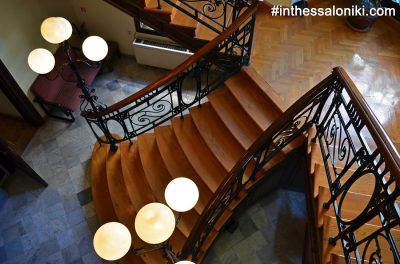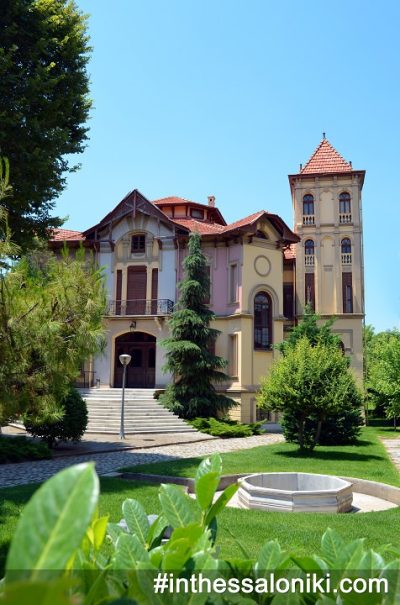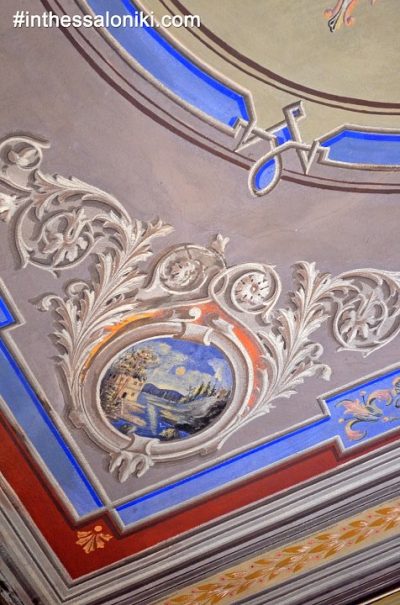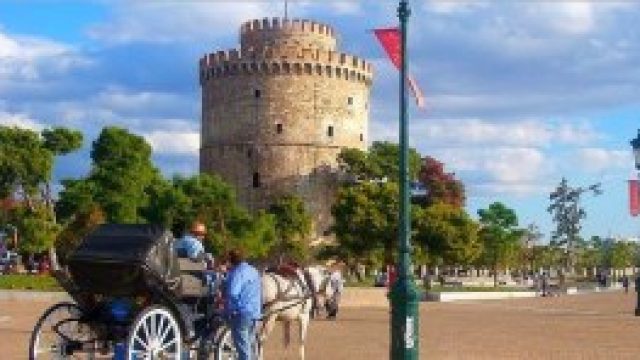Being one of the most beautiful buildings of the city, the villa was initially owned by the old-established Kapantzis family, whose presence in the city can be traced back to the late eighteenth century, when they figured prominently in the guild system.
The Villa Kapantzis, as it was named, was particularly lavish and the construction costs exceeded 40,000 gold sovereigns, a mythical amount in those days.
Architecture and decoration
The Villa Kapantzis was built on what used to be a seafront plot of 4,000 sq. m. At the time the west side was visible only from the sea.
The mansion essentially comprises two buildings, the main residence and the tower, which are linked to each other. The main building (16.50 m. wide, 19.00 m. long and 18.00 m. high) includes three storeys (a semi-basement, an elevated ground floor and a first floor) and an attic.
The tower (4.40 m. wide and 6.60 m long) is four-storeyed and the part above the ground floor is open. The main entrance is on the side facing the historic Vasilissis Olgas Avenue.
The architecture displays overt Central European influences. Essential features include the complex volumes, a multi-level roof with steep slopes and the tall, rectangular tower. The decoration of the building’s interior is rich and varied, thus differentiating each room.
The floors are of different materials (marble in the entrances, parquet flooring in the reception areas and wooden boards in the remaining areas), as are the doors, windows and storeys. Wood-carved ornaments and wainscot paneling distinguishes the areas and rooms.
The double-flight staircase is of monumental character and is decorated with wooden veneer, elaborate balustrade and lighting. The ceilings of the ground and first floor are painted, apart from the central areas. Unfortunately, most of them have been destroyed, except for some samples, on the basis of which an attempt has been made to restore the compositions, wherever the necessary evidence was available.
History Of The Building
In 1912, following the incorporation of Thessaloniki into the Greek state, the villa served as the residence of Prince Nicholas, the first Military Governor of the city. In 1917, the Villa Kapantzis enjoyed its most glorious days as home of Prime Minister Eleftherios Venizelos, then head of a Provisional (revolutionary) Government, based in Thessaloniki, during a critical period in the history of Greece.
Between 1918 and 1922 the villa was the residence of the Kapantzis and Cohen families. Following the Greek defeat in Asia Minor (1922) and until 1928, refugee families were accommodated in its rooms.
In 1928 the building was acquired by the National Bank of Greece, as an exchangeable asset, and was used as the headquarters of the American Foundation Company, which carried out major land reclamation works in Central Macedonia.
Between 1938 and 1972, excepting the period of the Second World War, the villa housed the Fifth Boys High School. Thus, thousands of Thessalonikans have lived in the Villa Kapantzis, as pupils of one of the city’s most prestigious secondary schools.
Occupation, abandonement and restoration
In 1940 the building was requisitioned by the Greek Army and was used as a military bakery. During the German Occupation (1941-1944), it was requisitioned by the German authorities. Following the liberation, it served as British Army headquarters until the summer of 1945, when it was returned to the Fifth Boys’ High School, which remained there until 1972.
In that year the building was abandoned in dilapidated state and in need of serious repairs, following its long-term usage in different capacities. In response to public demand, the National Bank of Greece decided to restore the building and to use it for cultural purposes. The painstaking restoration process lasted from 1982 to 1988.
The relevant study aimed at minimizing interventions that might alter the original character of the villa, whilst at the same time preserving its authentic features.
- The building that houses the Cultural Center of MIET in Thessaloniki is one of the few extant, late nineteenth-century mansions and one of the most important modern monuments in the city. It not only preserves a vivid picture of what was once the Exochon Quarter but is also a vital part of the city’s recent history. It definitely deserves your attention.



















Leave a Reply